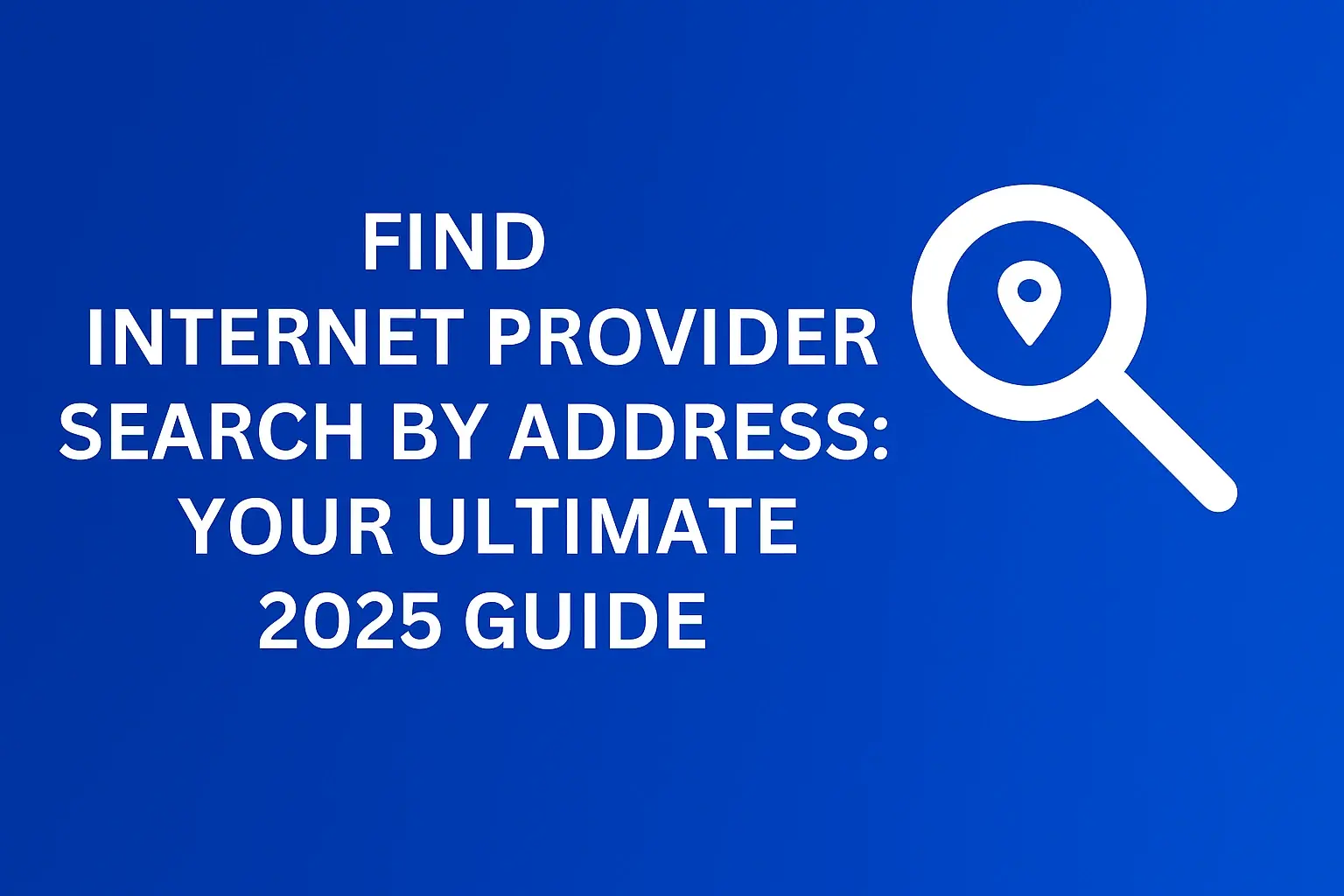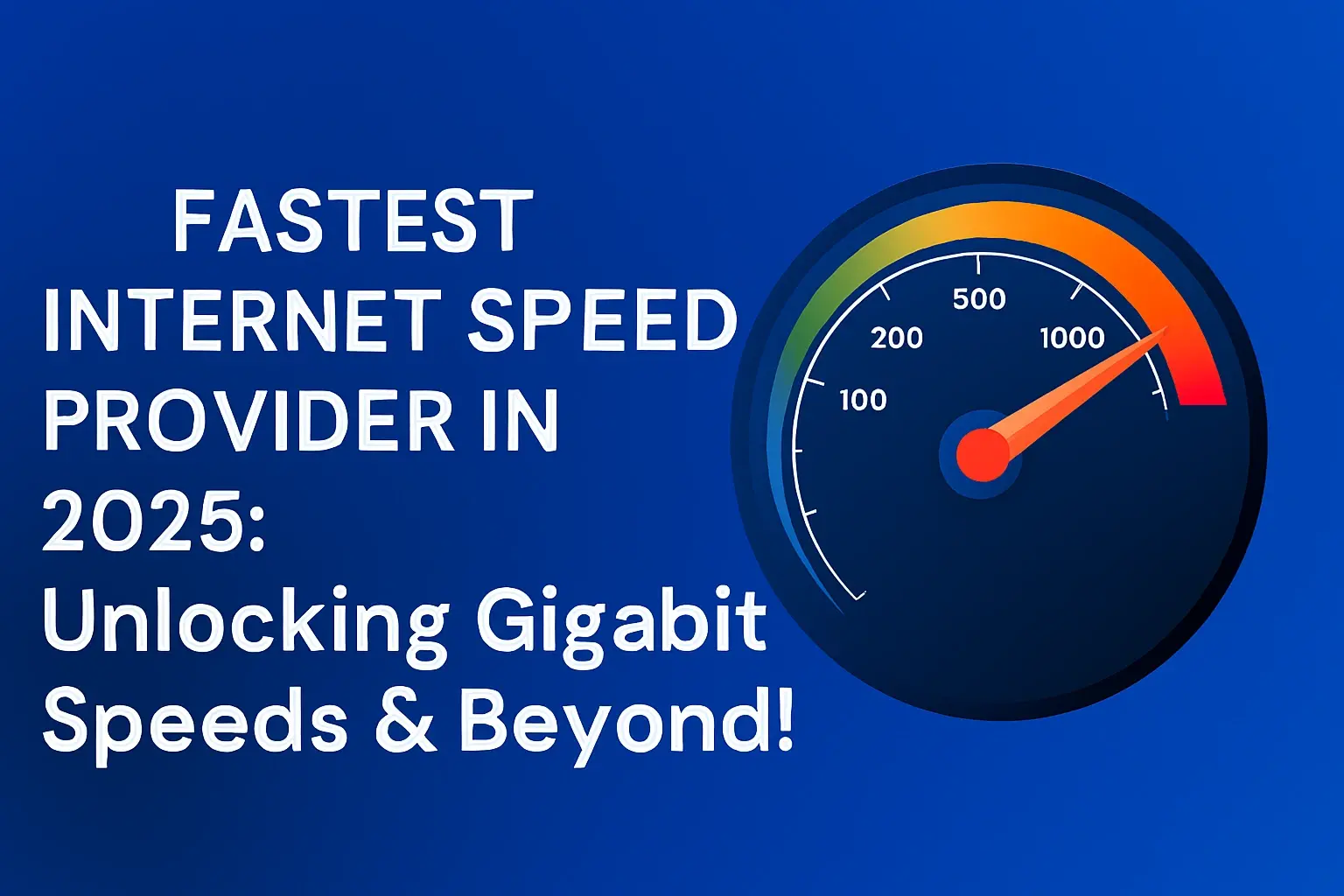Choosing the Right Internet Provider for My Address

Finding the perfect internet provider for your specific address can feel like navigating a maze. This guide cuts through the complexity, offering a clear, actionable roadmap to compare options, understand key factors like speed and cost, and ultimately select the service that best fits your needs and budget in 2025.
Understanding Internet Availability in Your Area
The very first hurdle in choosing the right internet provider for your address is understanding what services are actually available to you. This isn't a one-size-fits-all situation; availability is dictated by your geographic location, the infrastructure built by various companies, and even the specific type of dwelling you inhabit. In 2025, while broadband penetration is high, there are still significant disparities, especially in rural or underserved urban areas. Ignoring this crucial first step can lead to disappointment and wasted time researching providers who simply don't service your home.
The Role of Your Address in Provider Options
Your physical address is the key that unlocks your internet options. Internet Service Providers (ISPs) have specific service areas determined by their network infrastructure. Fiber optic cables, coaxial cables (used for cable internet), and telephone lines (for DSL) are laid out in specific patterns. Satellite and fixed wireless, while less dependent on ground infrastructure, still have limitations based on line-of-sight or satellite dish placement capabilities. Therefore, the most effective way to begin your search is by inputting your exact street address into the availability checkers of major ISPs operating in your region.
Leveraging Online Availability Tools
Most reputable ISPs provide tools on their websites that allow you to check serviceability by address. These are invaluable. Simply navigate to their homepage and look for a "Check Availability," "Find Plans Near You," or similar link. You'll typically be prompted to enter your zip code, street address, and sometimes even your unit or apartment number. The results will show you which of their services, if any, are available at your location. It's wise to check with multiple providers, as one company's network might extend to your address while another's does not.
Beyond Major ISPs: Exploring Local and Niche Providers
While large national providers often dominate the market, don't overlook smaller, regional ISPs or even municipal broadband initiatives. In some areas, these smaller players may offer competitive speeds or more affordable plans, especially if they've invested in newer infrastructure. Fixed wireless providers, which use radio signals to connect homes, can also be a viable option in areas where traditional wired infrastructure is lacking. These often require a clear line of sight to a tower. Similarly, satellite internet has improved significantly, offering higher speeds than in the past, though latency can still be a concern for real-time applications. For a comprehensive understanding of all possibilities, consider using third-party comparison websites that aggregate data from a wider range of providers, including some of the less common ones.
Understanding Geographic Disparities in 2025
As of 2025, significant digital divides persist. Urban centers generally boast a wider array of high-speed options, including fiber and robust cable networks. However, even within cities, older neighborhoods or specific apartment complexes might have limited choices due to the existing infrastructure or building management agreements. Rural areas continue to face challenges, with DSL and satellite often being the primary, if not only, options. Fixed wireless is bridging some of these gaps, but its effectiveness is highly dependent on proximity to towers and terrain. Recognizing these disparities early helps manage expectations and focus your search on realistic solutions.
The Impact of Infrastructure Investment
The availability of different internet types is directly tied to past and ongoing infrastructure investment. Companies are more likely to deploy advanced technologies like fiber optic cables in densely populated areas where they can achieve a higher return on investment. Government initiatives and subsidies are playing a crucial role in encouraging ISPs to expand into less profitable rural or underserved regions. These efforts are ongoing in 2025, meaning new options might become available over time. Staying informed about local infrastructure projects can be beneficial.
What to Do If Options Are Limited
If your address shows very limited provider options, don't despair. First, double-check your address for any potential input errors. Then, explore all available technologies, even those you might have previously dismissed. For instance, if cable is unavailable, could DSL provide a sufficient speed? If wired options are scarce, investigate fixed wireless and satellite. Sometimes, contacting building management (if you're in an apartment or condo) can reveal hidden provider agreements or potential for new service installations. Advocate for better service by contacting local government representatives about broadband expansion initiatives.
Decoding Internet Connection Types
Once you know which providers are available at your address, the next critical step is understanding the different types of internet connections they offer. Each technology has its own strengths, weaknesses, and typical performance characteristics. In 2025, the landscape includes established technologies like DSL and Cable, alongside newer, faster options like Fiber Optics and Fixed Wireless, and the ever-present Satellite. Knowing the differences will empower you to choose a plan that aligns with your online activities.
Fiber Optic Internet
Fiber optic internet is widely considered the gold standard for residential broadband. It uses strands of glass or plastic to transmit data as pulses of light. This technology offers incredibly high speeds, both for downloads and uploads, and is highly resistant to interference and signal degradation over long distances. Fiber also boasts very low latency, making it ideal for online gaming, video conferencing, and other real-time applications. As of 2025, fiber is expanding rapidly, but its availability is still concentrated in urban and suburban areas where significant infrastructure has been laid.
- Pros: Highest speeds, symmetrical upload/download speeds, low latency, reliable, future-proof.
- Cons: Limited availability, can be more expensive.
Cable Internet
Cable internet is delivered through the same coaxial cables that bring cable television to your home. It uses a modem to translate the signals from the cable line into data your devices can use. Cable offers a good balance of speed and availability, with many providers offering plans that are more than sufficient for typical household use. However, cable internet is a shared network, meaning speeds can sometimes slow down during peak usage hours when many people in your neighborhood are online. Upload speeds are typically much lower than download speeds.
- Pros: Widely available, good download speeds, competitive pricing.
- Cons: Slower upload speeds, speeds can fluctuate during peak hours, shared network.
DSL (Digital Subscriber Line) Internet
DSL internet uses existing telephone lines to transmit data. It offers a significant upgrade over dial-up but is generally slower than cable or fiber. The speed of DSL is heavily dependent on the distance between your home and the provider's central office; the farther away you are, the slower the connection will be. DSL is a good option for basic internet use like browsing, email, and standard-definition streaming, especially in areas where other options are limited or too expensive. As of 2025, DSL is being phased out in many areas in favor of more advanced technologies.
- Pros: Widely available (where phone lines exist), can be affordable, dedicated line (less affected by neighbors).
- Cons: Slower speeds compared to cable/fiber, speed degrades with distance, slower upload speeds.
Fixed Wireless Internet
Fixed wireless internet uses radio signals transmitted from a local tower to a receiver installed at your home. It's a viable alternative in rural or suburban areas where laying cables is cost-prohibitive. Speeds can vary significantly depending on the provider, the equipment used, and the line of sight to the tower. It can offer competitive speeds, sometimes even approaching those of cable, but is susceptible to weather conditions and obstructions. Latency can be a concern for some applications.
- Pros: Good option for rural areas, can offer decent speeds, faster to deploy than wired options.
- Cons: Requires line of sight to tower, susceptible to weather, speeds can vary, potential for interference.
Satellite Internet
Satellite internet involves a satellite dish at your home communicating with a satellite in orbit, which then relays data to a ground station. It's available almost anywhere with a clear view of the sky, making it a crucial option for extremely remote locations. However, satellite internet traditionally suffers from high latency due to the vast distance data must travel. While speeds have improved, and some providers offer lower latency options in 2025, it's generally not ideal for real-time activities like online gaming or frequent video conferencing. Data caps are also common.
- Pros: Available almost anywhere, good for remote locations.
- Cons: High latency, speeds can be inconsistent, data caps, susceptible to weather, can be expensive.
Understanding Bandwidth and Speed
When comparing plans, you'll see terms like "up to X Mbps download" and "Y Mbps upload." Bandwidth refers to the maximum amount of data that can be transmitted over your internet connection in a given time. Speed is how fast that data is transmitted. For most households in 2025, download speeds are more critical for activities like streaming video, downloading files, and browsing websites. Upload speeds are important for video calls, uploading large files, and online gaming. Symmetrical speeds (where download and upload are equal) are a hallmark of fiber optic connections.
Latency: The Unsung Hero
Latency, often measured in milliseconds (ms), is the time it takes for a data packet to travel from your device to a server and back. Low latency is crucial for responsive online experiences. High latency can cause lag in video games, delays in video calls, and a general sluggish feel to interactive websites. Fiber optic connections typically have the lowest latency, while satellite connections have the highest.
Key Factors When Choosing an Internet Provider
Selecting the right internet provider involves more than just looking at advertised speeds. Several critical factors influence the overall value and suitability of a service for your specific needs. In 2025, as internet usage becomes more integrated into daily life, understanding these nuances is paramount to avoiding frustration and ensuring you get the best bang for your buck. This section delves into the essential elements you should evaluate.
Speed Requirements: Matching Your Usage
The first step is to honestly assess your household's internet usage. How many people will be using the internet simultaneously? What activities do you primarily engage in?
- Basic Browsing & Email: 10-25 Mbps download is generally sufficient.
- Streaming Standard Definition (SD) Video: 25-50 Mbps download is recommended.
- Streaming High Definition (HD) Video: 50-100 Mbps download is ideal.
- Streaming 4K Ultra HD Video: 100-200 Mbps download is recommended.
- Online Gaming: Requires good download speeds (50-100+ Mbps), but more importantly, low latency and decent upload speeds (10-20+ Mbps) for multiplayer experiences.
- Heavy Use (Multiple Devices, 4K Streaming, Large Downloads/Uploads): 200 Mbps download and above, with good upload speeds if possible.
Data Caps and Overage Charges
Many internet plans, particularly satellite and some fixed wireless or mobile hotspot plans, come with data caps. These limit the amount of data you can download or upload each month. Exceeding these caps can result in significantly slower speeds or hefty overage charges. It's crucial to understand your typical monthly data usage. You can often find this information in your current provider's billing statements or by using online tools that estimate usage based on your activities. For heavy streamers or large file users, unlimited data plans are highly recommended. As of 2025, many cable and fiber providers offer unlimited data, but it's always wise to confirm.
Pricing and Hidden Fees
Advertised prices are rarely the final price. Be sure to inquire about:
- Installation Fees: Some providers charge a one-time fee for setting up your service.
- Equipment Rental Fees: You might need to rent a modem or router from the ISP. Buying your own compatible equipment can often save money in the long run.
- Promotional vs. Standard Pricing: Many providers offer attractive introductory rates that increase significantly after a promotional period (e.g., 12 or 24 months). Understand what the standard price will be after the promotion ends.
- Early Termination Fees (ETFs): If you break a contract early, you could face penalties.
- Taxes and Surcharges: These can add a noticeable amount to your monthly bill.
Contract Length and Commitment
Some internet plans require a contract, typically for 12, 24, or even 36 months. While contracts can sometimes lock in a lower promotional price, they also tie you to a specific provider. If you move or find a better deal, you might incur early termination fees. Month-to-month plans offer more flexibility but may have higher standard rates. In 2025, the trend is towards shorter contracts or no-contract options, but it's essential to verify the terms. If you anticipate moving within the contract period, a no-contract option is usually preferable.
Customer Service and Reliability
Speed and price are important, but so is the quality of customer service and the reliability of the connection. Read online reviews and check consumer reports to gauge customer satisfaction with different providers in your area. Look for information regarding uptime (how often the service is operational) and the responsiveness of their technical support. A provider with excellent speeds but poor customer service can be a significant source of frustration.
Understanding Upload vs. Download Speeds
As mentioned earlier, download speeds are for receiving data, while upload speeds are for sending data. For most users, download is more critical. However, if you frequently participate in video calls, upload large files to cloud storage, or stream your own content, upload speed becomes increasingly important. Fiber optic connections are the only ones that typically offer symmetrical (equal) upload and download speeds. Cable and DSL generally have much slower upload speeds. Fixed wireless and satellite can vary.
The Importance of Latency for Certain Activities
Latency, or ping, measures the delay in data transfer. For activities like online gaming, live video conferencing, and even fast-paced web browsing, low latency is crucial. High latency can make these activities feel sluggish or unresponsive. Fiber optic connections consistently offer the lowest latency. Cable and DSL have moderate latency, while satellite internet typically has the highest latency due to the distance data must travel to and from orbit. When choosing a provider, consider your most demanding online activities.
Comparing Providers and Plans: A Step-by-Step Guide
Now that you understand the types of connections and the key factors to consider, it's time to put that knowledge into action. This step-by-step guide will help you systematically compare internet providers and plans to find the best fit for your address. In 2025, with numerous options available, a structured approach is essential to avoid confusion and ensure you make an informed decision.
Step 1: Confirm Availability at Your Address
As discussed earlier, this is the non-negotiable first step. Visit the websites of major ISPs in your region (e.g., Xfinity, Spectrum, Verizon Fios, AT&T Fiber, CenturyLink, HughesNet, Viasat) and enter your exact street address. Also, search for smaller, local providers or municipal broadband options. Third-party comparison sites can help aggregate this information. Note down which providers and types of connections are available to you.
Step 2: Identify Your Speed Needs
Refer back to the section on speed requirements. List the minimum and ideal download and upload speeds required for your household's typical activities. Consider the number of users and devices. It's better to have slightly more speed than you need than to be constantly frustrated by slow performance.
Step 3: Research Available Plans from Each Provider
For each provider that services your address, list the plans they offer. Pay close attention to:
- Advertised Download and Upload Speeds
- Monthly Price (and duration of any promotional pricing)
- Data Caps (if any)
- Contract Length
- Equipment Rental Fees
Example Comparison Table (Illustrative - 2025 Data)
| Provider | Connection Type | Download Speed (Mbps) | Upload Speed (Mbps) | Monthly Price (Promo/Standard) | Data Cap | Contract Length |
|---|---|---|---|---|---|---|
| FiberFast ISP | Fiber Optic | 1000 | 1000 | $70 / $90 | Unlimited | 12 Months |
| CableNet Solutions | Cable | 500 | 20 | $60 / $80 | 1.5 TB | No Contract |
| DSL Connect | DSL | 50 | 5 | $45 / $65 | Unlimited | 24 Months |
| SkyLink Wireless | Fixed Wireless | 100 | 10 | $65 / $75 | 500 GB | 12 Months |
Step 4: Investigate Hidden Fees and Total Cost
Once you have the basic plan details, dig deeper. Contact customer service or review the provider's terms of service to understand all potential fees: installation, equipment rental, activation, taxes, and surcharges. Calculate the total estimated monthly cost, considering both promotional and standard pricing after the introductory period. Also, factor in the cost of purchasing your own modem/router if that's an option and a cost-saving measure.
Step 5: Read the Fine Print on Contracts and Data Caps
Carefully review any contract terms. What are the early termination fees? How are data overage charges calculated? Are there any clauses that allow the provider to change terms or prices unilaterally? Understanding these details can save you significant money and headaches down the line. For data caps, estimate your monthly usage and see how it compares to the plan's allowance. If you're close to the cap, consider a plan with more data or unlimited data.
Step 6: Research Customer Service and Reliability
Use online review sites (like Yelp, Google Reviews, BBB), forums, and consumer advocacy groups to gauge customer satisfaction with the providers you're considering. Look for patterns in complaints regarding billing, technical support, and service outages. While individual reviews can be biased, a consistent trend is a good indicator of service quality. You can also ask neighbors about their experiences.
Step 7: Consider Bundling Options (with Caution)
Many ISPs offer bundles that combine internet, TV, and phone services. These can sometimes offer savings compared to subscribing to each service separately. However, always do the math. Sometimes, the bundled price is not significantly lower, or you might end up paying for services you don't need. It's often best to price out each service individually and then compare it to the bundled offer.
Making the Most of Comparison Websites
Websites like BroadbandNow, HighSpeedInternet.com, and others are excellent resources. They allow you to enter your address and see a consolidated list of available providers and plans, often with user reviews and detailed plan breakdowns. However, always cross-reference the information with the provider's official website, as offerings can change rapidly.
What If All Options Seem Equal?
If you find yourself with multiple providers offering similar speeds and prices, consider factors like contract length, customer service reputation, and the likelihood of future upgrades. A provider with a strong track record of investing in their network might be a better long-term choice, even if the initial offering is comparable.
Navigating Contracts, Fees, and Fine Print
The allure of a low monthly price can be deceiving. Internet providers often have complex pricing structures, contracts, and a variety of fees that can significantly inflate your actual cost. In 2025, it's more important than ever to scrutinize these details to avoid unexpected charges and ensure you're getting genuine value. This section breaks down the common pitfalls and how to navigate them effectively.
Deconstructing the Contract
Many internet plans, especially those offering introductory discounts, come with a contract. These are typically for 12, 24, or even 36 months.
- Pros of Contracts: Can lock in lower promotional pricing for the duration of the contract.
- Cons of Contracts:
- Early Termination Fees (ETFs): If you need to cancel the service before the contract ends (e.g., due to moving, dissatisfaction, or finding a better deal), you will likely incur a substantial fee, often calculated on a per-month basis remaining on the contract.
- Lack of Flexibility: You are committed to the provider, limiting your ability to switch if better options become available.
- Potential for Price Increases: While the promotional rate is fixed, some contracts may allow for other fees or price adjustments under specific circumstances.
Common Fees to Watch Out For
Beyond the advertised monthly service fee, be aware of these potential charges:
Installation Fees
This is a one-time charge for setting up your internet service. Some providers offer free installation, especially during promotional periods, while others can charge anywhere from $50 to $200 or more. Self-installation kits are sometimes available for free or a nominal fee, which can be a good way to save money if you're comfortable with basic setup.
Equipment Rental Fees
ISPs typically require you to use their modem and/or router. They often charge a monthly rental fee for this equipment, which can range from $10 to $20 per month. Over the course of a year, this adds up significantly. Many providers allow you to purchase your own compatible modem and router, which can be a substantial cost-saving measure. Ensure any equipment you buy is on the provider's approved list to avoid compatibility issues. Check FCC guidelines on modem compatibility.
Activation Fees
Similar to installation fees, this is a one-time charge for activating your service on the provider's network. These fees can vary widely.
Taxes and Surcharges
These are government-imposed taxes and fees levied by the ISP, as well as regulatory fees. They can add anywhere from 5% to 20% or more to your monthly bill. While often unavoidable, understanding their presence is key to budgeting.
Data Overage Charges
If your plan has a data cap, exceeding it will likely result in overage charges. These can be extremely expensive, sometimes costing $10 or more per gigabyte of data used beyond your limit. Some providers will simply throttle your speed to a very slow rate instead of charging overages, which can also be highly inconvenient. Always understand your data allowance and how overages are handled.
Understanding Promotional Pricing vs. Standard Pricing
Most advertised internet deals are promotional prices designed to attract new customers. These rates are typically valid for a limited time, such as 12 or 24 months. After this period, the price will automatically revert to the provider's standard rate, which can be significantly higher.
- Actionable Tip: Always ask, "What will the price be after the promotional period ends?" and "Are there any other fees or price increases I should be aware of?"
The Fine Print of Service Level Agreements (SLAs)
For business internet, Service Level Agreements (SLAs) are common and guarantee certain levels of uptime and performance. For residential services, formal SLAs are rare, but the provider's terms of service outline their obligations and your rights. It's worth a quick scan to understand what guarantees, if any, are in place regarding service availability and performance.
Negotiating Your Internet Bill
Don't be afraid to negotiate. Many providers are willing to offer discounts or waive certain fees, especially if you are a new customer or if you are threatening to switch to a competitor. If you've been a loyal customer, you might be able to get a better deal by calling and inquiring about current promotions or loyalty discounts. Mentioning competitor offers can be a powerful negotiation tactic.
What to Do About Unwanted Fees
If you discover unexpected fees on your bill, contact the provider's customer service immediately. Keep records of your conversations, including dates, times, and the names of the representatives you spoke with. If you believe you were wrongly charged, dispute the fee with the provider and, if necessary, escalate the issue to consumer protection agencies or the Better Business Bureau.
Making Your Final Decision and Installation
You've done the research, compared the plans, and navigated the tricky world of contracts and fees. Now it's time to make the final decision and prepare for installation. This stage involves confirming your choice, understanding the installation process, and ensuring a smooth transition to your new internet service. In 2025, with a focus on customer experience, most providers aim for a straightforward setup.
Finalizing Your Choice: A Quick Checklist
Before you commit, run through this final checklist:
- Availability Confirmed: Is the service definitely available at your address?
- Speed Meets Needs: Does the plan offer sufficient download and upload speeds for your household?
- Data Cap Acceptable: Is the data allowance sufficient, or is it unlimited?
- Total Cost Understood: Do you know the full monthly cost, including all fees and the post-promotional price?
- Contract Terms Clear: Are you comfortable with the contract length and any associated ETFs?
- Customer Service Reputation: Does the provider have a generally good reputation for support?
- Equipment Decision Made: Will you rent or buy your modem/router?
Signing Up: The Process
Once you've chosen a provider and plan, you'll typically sign up online or over the phone. Be prepared to provide:
- Your full name and contact information
- Your service address
- Payment information (for activation fees, first month's service, and equipment if purchased upfront)
- Social Security Number (often required for credit checks, especially for new customers or those without a long credit history)
Preparing for Installation Day
Whether you're having a professional installer or doing a self-installation, preparation is key:
Professional Installation
- Clear Access: Ensure the technician has clear access to the point where the internet line enters your home (e.g., outside wall, utility box) and to the location where you want your modem/router set up.
- Power Outlet: Make sure there is a working power outlet near where the modem/router will be placed.
- Wi-Fi Location: Consider where you want your Wi-Fi signal to be strongest. Placing the router in a central, open location is usually best.
- Pets and Children: Secure pets and supervise children to ensure they don't interfere with the technician's work.
- Questions Ready: Prepare any questions you have about your new service, Wi-Fi setup, or equipment.
Self-Installation
If you opt for self-installation, the provider will ship you a modem/router and necessary cables.
- Follow Instructions Carefully: Read all instructions provided by the ISP.
- Identify Connection Point: Locate the cable outlet, phone jack, or fiber termination point in your home.
- Connect Equipment: Connect the modem to the wall outlet and then to your router (if separate). Plug in the power.
- Activate Service: Follow the ISP's instructions to activate your service online or by phone. This usually involves visiting a specific webpage or calling an automated system.
- Configure Wi-Fi: Set up your Wi-Fi network name (SSID) and password.
Post-Installation: Testing and Optimization
Once your service is active, it's crucial to test its performance:
- Speed Test: Use a reliable speed test website (e.g., Speedtest.net, Fast.com) from a device connected directly to the modem/router via Ethernet cable, and then from a Wi-Fi connected device. Compare the results to the speeds advertised in your plan.
- Test Various Activities: Stream a video, make a video call, play an online game, or download a large file to ensure everything performs as expected.
- Wi-Fi Optimization: If your Wi-Fi signal is weak in certain areas, consider repositioning the router, using a Wi-Fi extender, or investing in a mesh Wi-Fi system.
Understanding Your New Equipment
Familiarize yourself with your new modem and router. If you purchased your own equipment, ensure you have the manuals. If you're renting, the ISP's website will likely have support documentation. Knowing how to restart your modem/router can often resolve minor connectivity issues.
What to Do with Your Old Provider
If you're switching providers, remember to officially cancel your old service. If you were under contract, be aware of any potential early termination fees. Return any equipment (modem, router, cable box) that you were renting from your previous provider to avoid additional charges.
Choosing the right internet provider for your address in 2025 requires diligence and a clear understanding of your needs and the available options. By systematically assessing availability, understanding connection types, evaluating key factors like speed and data caps, and carefully reviewing contracts and fees, you can confidently select a service that offers reliability, performance, and value. Don't settle for less; invest the time to find the internet connection that truly powers your digital life.





